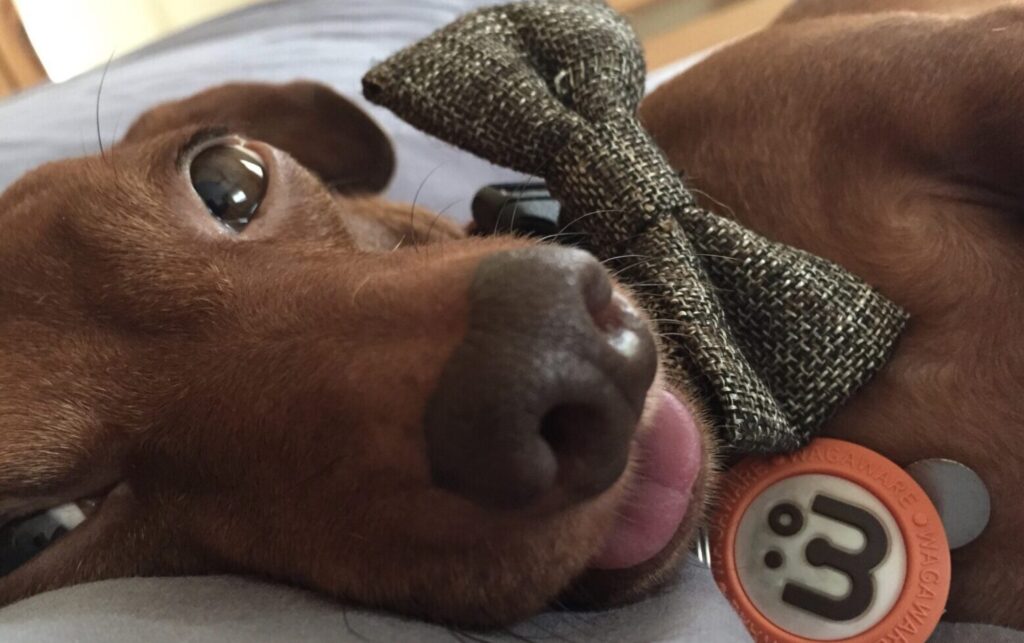The truth about some of these social dogs myths may surprise you. Let’s take a look at them together and discover why they are not always true. I’m sure there are many more myths! Please share yours in the comment section below.
My dog will never bite
I drilled into my child from birth, if it has teeth it can bite. Does Mommy have teeth? Yes. So she can bite.
We do our dogs a disservice if we ignore the fact that at some point every one of us will bite. My offspring was never bitten — by a dog that is — in spite of the numerous and varied dogs she encountered until adulthood. Sure, I’ll take credit for that!
Social dogs who play safely with other dogs and their caregivers learn bite inhibition. None-the-less dogs who can not make a scary thing go away by growling or using another technique like escape; biting may be imminent.
- Never reprimand your dog for growling.
- Know any dog can bite and how to avoid it.
- Teach children how to avoid bites.
If your dog does bite, be realistic. Look at what lead up to the bite and don’t jump to conclusions about the dog’s behavior. Definitely get professional help!
Dogs need constant human companionship and enrichment
Dogs sleep more than 12 hours a day. I have owned and operated dog daycares for more than 20 years, often caring for 40 dogs a day and can confirm this is true. In fact, 12 hours is a low estimate for some individuals. Not enough rest can make your best friend’s behavior become hyperactive or pushy. They may even struggle to get along with their friends.
Let sleeping dogs lie. Give them a place safe from interruption to do so. Crates are a wonderful tool for this in a busy household with limited room. Leave the door open and encourage them to go there when they need a break.
Know your dog – or other companion. Their age, breed, upbringing, diet, and other things will affect the amount of interaction they need from you. Help them get the rest they need.
Dogs always need room to run
People who are tired of living with a hyper dog they never trained often use this excuse with me in rescue to feel less guilt about giving them away. More than one person, who wanted to surrender their middle-aged dog they had since a puppy, told me: I’m selling my house and land to move to an apartment and my dog won’t like it.
While that may be the case for some dogs, most of the dogs I’ve known in rescue would have chosen to stay with their family rather than have more room to run. Think big picture before adopting a dog. It is a commitment for the life of the dog. If you may downsize in the future, don’t adopt a young, active dog.
Dogs do need mental and physical exercise just like we do and there are many ways to provide it without severing the family ties dogs crave.
Dominance
Oh boy do I dislike this word as applied to dogs. Are dogs either dominant or submissive? Few beings are dominant all of the time, dogs and people included. Behavior fluctuates constantly and depend upon our current mood and the others around us, among other things.
Too often we do not understand what our dogs are communicating to us. A dog pushing through a door before you may simply be excited for an opportunity to go to the bathroom or to play. Pulling on the leash… see below! I’ve known and interacted with many dogs. It’s never so simple!
Dogs Who Show Their Belly are Submissive
Submission and dominance are fluid in my experience. I’ve never seen a social animal be one or the other all of the time and in all circumstances. Puppies learn from other dogs. A dog may learn that lying on their back for a playmate makes that playmate back off while another learns this position as in invitation to play more.
Exposing their belly is a vulnerable position. If you don’t know the dog, give them space and make sure your dog does the same. Once you have experience with each other, you should understand what this dog is saying by rolling over.
Never force a dog to roll over to assert what you think is dominance. In my extensive observation of dogs interacting socially, “alpha rolling” is cruel and dangerous.
Dogs who are good leaders and very social do not alpha-roll to gain status. High ranking dogs ignore first and foremost to show distaste for another dog’s behavior. They are so good at it, they could teach us how to ghost someone.
Sometimes dogs do roll over to show their vulnerability and to avoid confrontation. It’s just not always the reason all dogs do it, all of the time.
A Dog Wagging it’s Tail is Friendly
Dogs use their tails to show a wide range of emotion and to indicate many different things. A slow wagging, low-held tail may indicate caution and be a warning to you, not a welcome.
If you don’t know the dog, don’t assume anything. With your own dog watch and learn to become a good judge of what they want to communicate. What they do next is the key!
Dogs and Kids Make Great Friends
Let’s stop putting dogs at risk by casting them in the role of nanny to our children. Dogs are good at teaching their pups how to behave and, lacking thumbs, use their mouths to do so.
- Human skin is more delicate than a dog’s which is protected by a coat of hair.
- We are vulnerable to accidental injury by dog teeth.
- When standing, many dogs and children are face to face so when a dog corrects it may be to the child’s face.
- Children are not naturally empathetic and gentle.
My child is now an adult and I homeschooled with many other children for the first 13 years. Experience taught me that children learn to practice empathy over years. All interactions with other animals should be micromanaged at least until they do so.
Most, if not all children are too rough until they learn otherwise. It’s our job to teach our children and not safe to put a dog in a position to manage them.
The risks are too great: a child may be injured and the dog may lose their life.
Dogs Who Pull on Leash are Dominant
Plain and simple, dogs pull on leash because it gets them where they want to go. Dogs are amazing trainers. They are quite willing to teach us especially if we’re not paying attention. It’s sad when we don’t open the lines of communication with our dogs and teach them too.
So how do we teach a dog not to pull? Intentionally reward your dog’s curiosity and desire to sniff only when the leash is slack. If a dog pulls on the leash and forward momentum stops, the dog quickly learns moving forward requires slack on the leash.
It’s up to you how much pressure you require the dog to create to stop forward momentum. Dogs are very aware initially. You can chose, as I do, to use the lightest amount of pressure to stop. If they haven’t already been taught to pull accidentally, they catch on very quickly.
Watch for upcoming posts and videos on how to teach a dog new to a leash not to pull. Dogs who already pull hard on a leash need additional help from an expert.
Dogs and Cats Never Get Along
- It is extremely important to protect cats and closely monitor new relationships.
- Dogs in group may not act like one dog does alone with a cat.
- Many dogs chase a fleeing cat and get too worked up to be their friend if they catch them.
All that said, I’ve observed many dog/cat friendships that are lifelong.
Anytime you have a big difference in size between animals, it is good practice to supervise them closely. At some point you may come to trust them, just realize it is always a risk. With our latest housemate, a very young and tiny miniature dachshund, it was the cat I didn’t trust. Wilhelmina and PawPaw are now pretty good friends though I suspect the cat now wishes he hadn’t taught her to play kill so roughly.
The dogs in this picture have been friends with this cat for more than 7 years. Willowrose and Jesse are unusual because they can play with Hunter together and have no problems. I still watch though.
Dogs need to play with other dogs every day
I have spent over 20 years managing 40+ dogs in daycare. Trust me, it is not true. A handful of breeds, mixes, and individuals seem to enjoy playing with stranger dogs throughout their lifetimes. Many adult dogs do not.
It takes considerable effort to communicate with a stranger. The same is true for most of us. Socializing with other dogs can be good mental exercise for some dogs, especially those who live in a single dog household. Others don’t want to do it and we shouldn’t force them.
Imagine having no choice but to hang out with a bunch of strangers who don’t share any of your interests… every day. I have a visual of me in my 40s clubbing nightly for hours with a bunch of 20 year olds I do not know. Oof. I work for myself at home for a reason. Many of you probably agree.
Dogs, in my experience, are even less likely to socialize outside of and without their family than people are. If your dog is obviously unhappy going to daycare or the dog park, don’t make them do it. Find a local playmate they can play with for an hour or so on a regular basis or spend a little one-on-one time with them instead. You’ll both be better for it!



